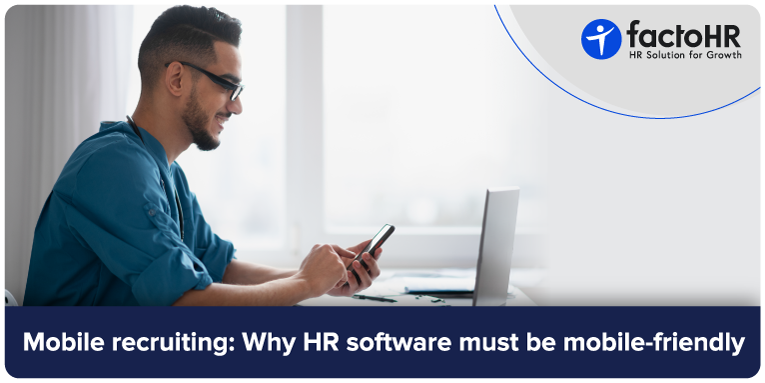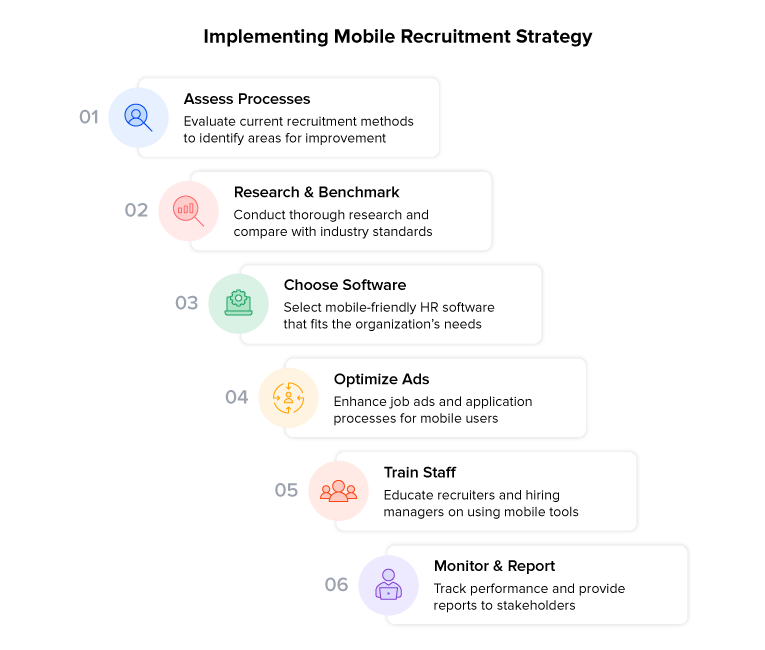What is Mobile Recruiting? 6 Top Strategies for 2025

Table of Contents
Smartphones pervade every aspect of our existence. We use them to find food, shop for groceries, book tickets, and even find jobs. Also, Smart devices have nearly replaced physical workplaces. Mobile recruiting has become a crucial process for any organization.
Both younger and older candidates rely on smartphones for searching and applying for new opportunities. Similarly, firms are also using job portals to hire talent. As a result, recruitment platforms like LinkedIn and Indeed are gaining even more traction than before.
In such a scenario, having a mobile-friendly HR software is essential, as it streamlines the recruitment process by digitizing all operations, including job posting and onboarding.
This guide explores the significance and meaning of mobile recruiting, highlighting the key differences between traditional and mobile recruitment methods. It also discusses the role of a mobile-friendly HR software for a recruitment approach.

What is Mobile Recruiting?
Mobile recruiting is a process that utilizes smartphones to attract and interact with candidates. Mobile-friendly recruitment is an approach that prioritizes smartphone users during the recruitment process. Recruiters optimize their campaigns for social media and rely on interactive apps when implementing a mobile-first recruitment approach.
In mobile recruiting, every step of the recruiting process, from job-posting to onboarding, is performed with the help of a smart device.
HR professionals post jobs on LinkedIn and other recruitment platforms. Candidates find and apply for available opportunities online, either on the firm’s website or on any other recruitment platform. Organizations are even conducting virtual interviews and offering digital onboarding for a personalized candidate experience.
Why Mobile Recruitment Matters in 2025?
Let’s look at some facts to understand why mobile recruitment is vital in 2025:
- By 2025, 80% of organizations in India are expected to struggle to find the right talent. Mobile recruitment could help in hiring top talent, especially when 68% of adults in India own a smartphone.
- Globally, 65% of job applications were submitted via mobile devices in 2024.
- 80% of recruiters believe that text messages improve candidate engagement.
The stats highlight that:
- Mobile recruiting can help firms tap top talent, as nearly everyone uses a smartphone.
- Candidates find it easier to submit job applications through smart devices. So, relying on mobile recruitment can improve your application completion rates.
- Mobile-first recruitment could enhance engagement, as recruiters and candidates can easily interact with each other.
Mobile recruitment could also address the needs of your recruitment cycle in less time, as it is faster and more efficient than traditional recruitment.

Traditional vs. Mobile Recruitment
Here’s a table providing a concise overview of the differences between traditional and mobile recruitment.
| Aspect | Traditional Recruitment | Mobile Recruitment |
|---|---|---|
| Reach | Limited. Candidates would find it difficult to apply from the dashboards. | Wide. Candidates can easily submit job applications through a smartphone. |
| Time duration | Takes more time due to a lack of on-the-go access. | Takes less time as candidates and recruiters have real-time access. |
| Difficulty | More difficult than mobile recruitment. | Easier than traditional recruitment, as sites and recruitment platforms are optimized for intuitive use. |
| Platforms | Ads, newspapers, and campaigns. | Recruitment platforms like LinkedIn and the firm’s career page. |
| Involvement. | Less engaging than mobile recruitment. | More engaging, as candidates can interact with messages, images, and videos. |
| Data-collection | It is difficult to collect data on time. | It is easier to collect and measure metrics, such as talent analytics, in a shorter amount of time. |
| Efficiency | Less efficient, as it is more cumbersome than mobile recruitment. | Highly efficient, as candidates and recruiters can access their smartphones on the go. |
| Convenience | Less convenient | More convenient |
Benefits of Mobile Recruiting
Mobile recruiting could be faster, efficient, cost-effective, and immersive. It could also provide a memorable candidate experience.
Faster Communication
On-the-go recruiting streamlines the job application process by offering a user-friendly interface and cloud storage for seamless resume uploading.
Increased Efficiency
Optimized career pages and smaller forms could encourage candidates to complete the application.
Cost-Effective
Smartphone-based recruiting saves cost, as you can post jobs on several platforms, including LinkedIn, Instagram, X, and WhatsApp.
Interactive
You can use other social media platforms, such as Snapchat, and ask candidates to submit short videos instead of resumes.
Personalized Candidate Experience
Managers can get in touch with interested candidates and resolve any potential queries. Additionally, cloud-based HR solutions can offer streamlined recruitment and onboarding processes, providing a completely digital experience.

Why HR Software Must be Mobile-Friendly?
Organizations must have a mobile-friendly HRMS software for implementing mobile recruitment strategies because:
- It would offer an all-in-one mobile application for performing every aspect of recruitment, including job posting and onboarding.
- Push notifications would notify candidates and managers about essential updates. For example, a candidate would get real-time updates about his selection.
- Digital onboarding would provide a seamless and hassle-free experience for both HR professionals and candidates. According to Deloitte, in 2024, 60% of HR leaders reported that mobile onboarding improves new hire retention rates by over 15%. Candidates can share documents, acknowledge organizational policies, and update personal details from their smartphones.
- HR managers could monitor recruitment processes from their smart devices in real-time.
6 Steps to Implement a Mobile Recruitment Strategy
Here are the six steps for implementing a mobile recruiting strategy:
- Assess current recruitment processes
- Research and benchmark
- Choose the right mobile-friendly HR software
- Optimize job ads and application processes
- Train recruiters and hiring managers
- Monitor, analyze, and report

Assess Current Recruitment Processes
Identify the strengths and weaknesses of your recruitment channels and onboarding processes. Ask candidates to submit feedback at the end of the hiring process. Based on the results, focus on improving specific areas for further improvement.
For example, if your onboarding process takes more time, consider an online solution that minimizes paperwork. Similarly, if you can identify effective source channels, consider software that helps measure recruitment analytics.
Research and Benchmark
Based on the results of your assessment, conduct a thorough research about the best practices of other organizations. Set measurable criteria. For instance, if a recruitment channel is more effective than others, then allocate more of your resources to that channel.
Choose the Right Mobile-Friendly HR Software
Choose the right mobile-friendly HR software for an efficient, fast, interactive, and personalized recruitment experience. The solution should feature AI chatbots, a digital onboarding process, and paperless document sharing, among other key elements.
Optimize Job Ads and Application Processes
Measure metrics such as the cost of a source channel, candidate conversion rate, and application completion rate to optimize your recruitment process. For example, if candidates find an Instagram reel more interactive, they focus on similar ad campaigns.
Train Recruiters and Hiring Managers
Recruiters and managers may need some time to adjust to mobile recruitment. Train them when necessary. For example, you might need to optimize your job description by including gender and race-neutral phrases. Training your managers in AI and VR technologies could help you be ready for the future.
Monitor, Analyse and Report
Continuously monitor your current recruitment process and adapt to changes. Continue to analyze the current processes and identify areas for improvement. Additionally, not all processes require a complete overhaul. In such a case, repeat those processes.
Future of Mobile-First Recruitment
Technological advancements, such as Artificial Intelligence (AI) and Augmented Reality (AR), are also influencing the recruitment process. Earlier, AI only analysed resumes. Now, AI is also identifying the right candidate based on other criteria such as company culture. Similarly, most of the onboarding and hiring tasks are automated by digital solutions. Augmented reality is also significantly altering the recruitment process. AR is facilitating immersive company tours and memorable interviews. AI chatbots are becoming commonplace and answering candidates’ queries.

Conclusion
Mobile recruiting is crucial for any organization, as it offers access to a vast talent pool. Mobile recruitment is faster, efficient, interactive, and more personalized than traditional recruitment.
Organizations should invest in mobile recruitment software to stay competitive and address issues such as talent shortages and low candidate engagement. What are you waiting for? Evaluate the available options and attract, interact with, and hire the right talent using mobile recruiting.
What is Mobile Recruiting Software?
A mobile recruiting software is a system that facilitates recruitment with mobile apps. With this software, HR managers can post jobs online. Similarly, candidates can apply for available positions using their smartphones.
What are the Key Aspects of Mobile Recruiting?
Here are the key aspects of mobile recruiting
- 1. Mobile-Friendly Platforms
- 2. Communication Channels
- 3. Social Media Integration
- 4. Recruitment Apps
Which is the Best Mobile Recruiting Software?
factoHR provides the best mobile recruitment module. It offers the following state-of-the-art features –
- On-the-go access,
- Self-onboarding,
- Push notifications,
- Chatbot for answering general queries, and
- Integration with social media platforms and job aggregators.
What are the Examples of Mobile Recruitment
Here are some of the popular examples of mobile recruitment –
- A firm posting job openings on its career page,
- An HR manager posting jobs on job boards like Indeed,
- A candidate finds a job opening on LinkedIn,
- An employee referring a firm to others on an employee referral platform,
- A post on Instagram or a WhatsApp group notifying about a job opportunity, and
- A firm conducting virtual interviews, among others.
How does Mobile Recruiting Work?
Here are a few general steps followed in mobile recruiting –
- The HR manager or head of department creates a job description (JD), specifying the job requirements.
- The JD is then posted on job aggregators, social media platforms, and career pages with a unified dashboard.
- Interested prospects find the job post and apply online.
- HR manager uploads resumes in bulk and reviews applications with the ATS.
- A virtual interview is conducted on conferencing apps and in app video facilities.
- The selected candidate accepts the offer online and uploads the required documents through a self-service portal.
What are the Top Recruiting Trends in 2025?
Here is a list of the top 5 recruiting trends in 2025 –
- AI chatbots: The majority of candidates prefer mobile-friendly chatbots for FAQs related to the hiring process
- AR and VR integration: Businesses are giving immersive tours and conducting immersive recruitment processes.
- Predictive analytics: Firms are relying on predictive analytics to predict candidate success based on candidate profiles and company culture.
- Interactive hiring: Managers are increasingly using social media platforms, such as WhatsApp, to reach out to candidates and answer their queries.
- Gamification: Interactive assessments and simulations are replacing traditional tests.
Grow your business with factoHR today
Focus on the significant decision-making tasks, transfer all your common repetitive HR tasks to factoHR and see the things falling into their place.

© 2025 Copyright factoHR


